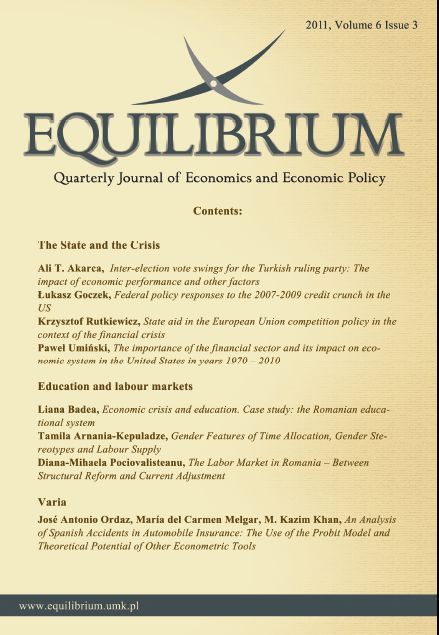Federal Policy Responses to the 2007?2009 US Credit Crunch
DOI:
https://doi.org/10.12775/EQUIL2011.018Keywords:
credit crunch, liquidity, finance, United States, monetary policyAbstract
This paper discusses the key characteristics of the U.S. financial crisis 2007-2009 and focuses on the Federal Policy Response to the lack of liquidity in the financial sector known as the ?Credit Crunch?. The surprising depth of the crisis required unprecedented policy measures to be used in order to tackle the mounting liquidity problems in banks and prevent the subsequent credit crunch from taking its toll in the real economy. This required extension of monetary powers of the Federal Reserve and Treasury, which was unmatched in history. The policy response to credit crunch and house price bust was especially important given the fact that recessions following such events tend to be much deeper and longer than any other types of recessions. More importantly, however, the analyses of the current policy responses will determine which form financial markets will take in the next few decades, thus how vulnerable the world economy will be to next disruptions and liquidity problems.
Downloads
References
Baba N., Packer F. (2009). From Turmoil to Crisis: Dislocations in the FX Swap Market Before and after the Failure of Lehman Brothers, ?Bank for International Settlements Working Paper No. 285, July.
Bernanke B., Gertler M. (1989). Agency Costs, Net Worth, and Business Fluctuations, ?American Economic Review?, vol. 79 (March), pp. 14-31.
Bernanke B., Gertler M., Gilchrist S. (1996). The Financial Accelerator and the Flight to Quality, ?Review of Economics and Statistics?, vol. 78 (February), pp. 1-15.
Bernanke B., Gertler M., Gilchrist S. (1999). The Financial Accelerator in a Quantitative Business Cycle Framework, in John B. Taylor and Michael Woodford, eds., Handbook of Macroeconomics, vol. 1, part 3. Amsterdam: North-Holland, pp. 1341-93.
Buiter, W., (2009), Negative Nominal Interest Rates: Three Ways to Overcome the Zero Lower Bound, "The North American Journal of Economics and Finance?, 20 (3), 213 ? 238.
Bordo, M., Landon-Lane J., (2010) The Global Financial Crisis of 2007-08: Is it Unprecedented?, NBER Working Paper No. 16589, December
Caballero, R., (2009) Complexity and Financial Panics, ?NBER Working Paper? No. 14997 Issued in May
Campello M., Graham J., Harvey C., (2009) The Real Effects of Financial Constraints: Evidence from a Financial Crisis ?NBER Working Paper? No. 15552 December 2009
Christensen, J.. Lopez, J. Rudebusch G., (2009). Do Central Bank Liquidity Facilities Affect Interbank Interest Rates?, ?Federal Reserve Bank of San Francisco Working Paper? 2009-13, June.
Cogan J.,Taylor J., (2010) What the Government Purchases Multiplier Actually Multiplied in the 2009 Stimulus Package, ?NBER Working Paper? No. 16505 October 2010
Gagnon, J., Raskin M., Remache J., Sack B., (2010). Large Scale Asset Purchases by the Federal Reserve: Did They Work? ?Federal Reserve Bank of New York Staff Report? No. 441, March.
Goldberg L., Kennedy C., Miu J. (2010), Central Bank Dollar Swap Lines and Overseas Dollar Funding Costs, ?National Bureau of Economic Research Working Paper? No. 15763, February.
Viral V. Acharya, Irvind Gujral, Nirupama Kulkarni, and Hyun Song Shin (2011) Dividends and Bank Capital in the Financial Crisis of 2007-2009,
?NBER Working Paper? No. 16896 March 2011
Jord? O., Schularick M., Taylor A., (2010), Financial Crises, Credit Booms, and External Imbalances: 140 Years of Lessons, ?NBER Working Paper? No. 16567, December 2010
Lerner J., Tufano P., (2011) The Consequences of Financial Innovation: A Counterfactual Research Agenda, ?NBER Working Paper? No. 16780 February 2011
McAndrews, J. (2009).. Segmentation in the U.S. Dollar Money Markets During the Financial Crisis, ?Paper presented at the International Conference of the Bank of Japan?s Institute for Monetary and Economic Studies?, Tokyo, May.
McAndrews, J., Sarkar A., Wang Z., (2008). The Effect of the Long-Term Auction Facility o the London Inter-Bank Offered Rate,? Federal Reserve Bank of New York Staff Report No. 335, July.
Mishkin, F. (2009). Is Monetary Policy Effective During Financial Crises, ?American Economic Review?, 99 (2): 573-577.
Mishkin, F. (2011) Monetary Policy Strategy: Lessons from the Crisis
?NBER Working Paper? No. 16755 February 2011
Reinhart C., Reinhart V., (2011), Pride Goes Before a Fall: Federal Reserve Policy and Asset Markets ?NBER Working Paper? No. 16815 February 2011
Reinhart C., Rogoff , K. (2011) A Decade of Debt ?NBER Working Paper? No. 16827 February 2011
Sarkar, A. Shrader J. (2010). Financial Amplification Mechanisms and the Federal Reserve?s Supply of Liquidity During the Crisis, ?Federal Reserve Bank of New York Staff Report ?No. 431. March.
Taylor, J.,. (2009), ?Zrozumieć kryzys finansowy?, PWN, Warszawa
Taylor, J.,. Williams J. (2009). A Black Swan in the Money Market, ?American Economic Journal: Macroeconomics? 1(1): 58-83.
Wu T., (2008). On the Effectiveness of the Federal Reserve?s New Liquidity Facilities,?Federal Reserve Bank of Dallas Working Paper., May.






